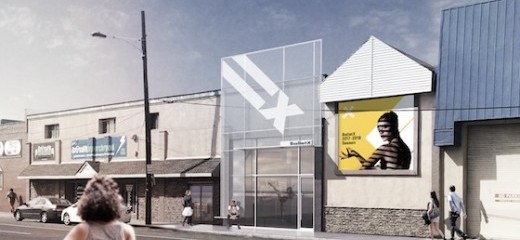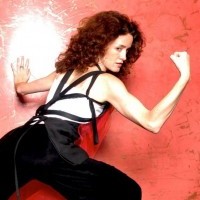
Christine Cox on A New Home for BalletX
by Carolyn Merritt
I recently sat down with Christine Cox, Artistic and Executive Director of BalletX, to chat about the company’s new home, The Center for World Premiere Choreography, scheduled to open in March. A major undertaking for any dance company, the $1 million-project marks a definitive moment in BalletX’s 12-year evolution. ISA Architects designed the renovation of the 5,000-square-foot former auto shop and furniture store that will house two studios. The company will utilize the space for morning class and rehearsal, as well as for choreographic residencies and community outreach. Located at 1923 Washington Avenue, the Center will bridge neighborhoods and populations—Point Breeze and Southwest Center City/Graduate Hospital—in much the same way the company has long bridged the worlds of ballet and modern dance. Describing the Center as “a set” that people will live and breathe in, Cox spoke of their new home as a space for dreaming, an innovation hub for the company and for contemporary ballet, and a place where Philadelphians of all stripes can connect through dance.
What does it mean for BalletX to have their own space?
It’s a really big deal for BalletX and we’re so excited for our next chapter in Philadelphia. When I pictured our new home in my mind I kept seeing the roots of a tree. Over the last 12 years this tree started off in a small planter that moved around, but now it’s being planted in the ground, it’s growing roots, and this will allow us to impact many more people in our community and abroad.
Was it part of your plan from the beginning?
No (laughs). I couldn’t even imagine. Building a company was about putting one foot in front of the other and just trying to do the next right thing, and trying to differentiate ourselves in how we cultivate our audience, our artists and our choreographers—and that’s still an evolving process. It became clear that running around in so many different places was not giving the organization its full potential. We were getting big enough that I thought we could do a better job of developing our work, expanding our community outreach, and strengthening our bond to the city in a new way. And already just planning for a new home has changed our thinking.
How so?
It feels much more about community, about the opportunity to touch more people. Now we can really plan. It’s no longer about reserving a space for a number of weeks, it’s “how do we bring life to a space? How do we create excitement and passion for an art form we love?” Now we can bring in supporters more often and more closely to the organization. The dancers can see better what the administration is doing and the administration can see better what the dancers are doing. There becomes a new entity of energy when you bring us all together, and we’re already an energized group.
It sounds like the Center is a combination of this vision to build the repertoire of contemporary ballet choreography, and also to create a space that serves beyond BalletX.
Yes, that’s the goal. We produce five to eight world premieres a year, which is pretty unheard of for a company of this size, but that is our core mission—expanding the vocabulary of classical dance. So the focus needs to remain on the choreography. I wanted the space to come together around the brand we’ve spent 12 years building. And with that, we’ll have levels of engagement that go directly to the top tier of that mission. We already have a one-of-a-kind choreographic fellowship program, in which emerging choreographers work with a mentor to produce a work. And I’m now looking for funding to support long-term residencies, where emerging choreographers will shadow the different main-stage choreographers we commission. Another big component will be the evolution of Dance eXchange, our in-school program, where we bring dance education to young people who might not otherwise be exposed to it.
How does the Dance Exchange program work—do you go to the schools?
It’s modeled after the National Dance Institute in New York City. They train us in their pedagogy, and then we train a team of seven teaching artists who go into three schools—Chester A. Arthur, Bache-Martin, and Greenfield—along with three musicians. Originally the idea was that BalletX dancers would do this program, but fortunately we’ve been working so much that it wasn’t realistic. I didn’t want the in-school program to dominate what the company was doing. The good news is we’ve created more opportunities for more people to work with the company.
And do you keep in touch with the students? Do they come to performances?
We’ve tried to develop a more through-line engagement for our students, so the annual theme of our Dance eXchange program is developed around what the company is performing. We’re doing Beautiful Decay now, which is about the aging body. We didn’t think that was a suitable theme for the young dancers, so we decided to use the first act’s music, Vivaldi’s The Four Seasons, to be the program focus. The teaching artists discuss what the company is doing and how we can connect the two programs. The students helped build some of the material for that section, and then they came to a performance at the Wilma. What we’ve found in the past five years is that kids fall in love with dancing through this program and then there’s nothing else we can offer them. So the space will allow us to provide more work for our teaching artists and more opportunities for students, to come to the Center after school and continue dancing. We hope to launch these new classes in the fall.
Another project we just received funding for that I’m very excited about is called Project eXpand, to expand our audience to better reflect the Philadelphia community. There will be much more information on this program when we move into our new home.
That was one of my questions—how does that happen?
We’re doing it through our Dance eXchange program. It’s going to take time to successfully reach a whole new audience, because you have to break down the barriers that keep people from wanting to come in. We’re building new partnerships, with organizations like Art Sanctuary, for example, and with young playwrights, because we want our audience to look like Philadelphia, which is a beautiful, diverse, awesome community. I grew up in West Philadelphia, I went to public school, and I’m so passionate about dance and its ability to move and connect communities. Our culture and our society have gotten so connected to things that are not tangible—we’re getting more disconnected as we evolve. This is one way we can encourage people to put down their phones, come in, dance with us, share and learn about why we do this, so it’s not only a thing for a certain sector in our community.
You’ll continue at the Wilma?
Yes, the Center won’t be a performance space. I was a bit terrified fundraising for the space; I struggled with how to articulate this next step to funders. But I started to visualize it like a set, for an opera or a ballet, and as soon as I changed the way I approached what we were creating and I didn’t feel guilty about building new dressing rooms, then I was able to elevate the conversation. This really is a set that we’re building, in a warehouse, but it doesn’t go away after two weeks. It’s a set that people get to live in, breathe in, experience, and that should inspire the work and take it to another level. I really believe it’s going to put Philadelphia on the map in the global dance community. We bring in choreographers from all over the world and until now we have never been able to call a place home. Now we can better curate their experience in Philadelphia.
Can you speak to the timing of BalletX announcing the opening of a new space just as the Painted Bride is preparing to sell their building?
I’m from Philly, I’ve performed at the Bride, it breaks my heart. I want every arts organization in our city to thrive and to sustain, and it can be challenging. I’m saddened by the fact that they’re selling the building. I’m hoping that whoever buys it understands the importance of keeping the Bride alive. It’s not easy running a non-profit. We’re not in Canada or Europe, where the governments have dedicated budgets to support arts and culture. In the U.S., every year you start anew, and as soon as you grow you’ve got to be able to maintain that growth. But I think we all have to be realistic that there is a lifetime to organizations, that they may not be forever. And that’s hard. It’s like accepting life in general and its terms.
I’m incredibly grateful for the network of people who believe in what BalletX is doing and who really stepped up [to support the Center]. And I mean REALLY stepped up. They know we’ll make sure it impacts the city in a positive way. As a Philadelphian, I care very much about this city. I come from parents who built things—my dad helped start the University City Swim Club, which was the first interracial private swim club in our country, and my parents both helped form the University City Arts League, where my mom was Executive Director. I didn’t realize I would be a part of that lineage, I was just trying to do something different from my regular job at Pennsylvania Ballet.
A Dance Journal piece on the groundbreaking cites your commitment to commission 40 new works by 25 choreographers over the next ten years, and quotes you declaring, “The Center will define BalletX’s next decade of dance-making as one of innovation and inclusion.” Where is BalletX with inclusion right now?
We have built a beautiful, passionate audience that is evolving, but I started to realize I could do a much better job of supporting more female choreographers and artists of color. I have always wanted our doors to feel open, to create a place where people want to come and understand the art form, where there’s no pretense. In order to do that you have to reflect your community and support artists of all stripes. I’m in the midst of producing a new piece by Darrell Moultrie, who’s from Spanish Harlem. It’s his second work for the company and it’s fabulous. I want to bring in students of all different backgrounds and for them to see artists they can relate to, who share stories they understand. Darrell can help us break down these barriers and inspire certain students in ways I cannot.
When I finally had a moment to step back and reflect on the last 12 years, I realized the majority of the work I produced was by white men. Don’t get me wrong, I love the work, but I want to balance out the playing field more and I need to be proactive in my curation of new work. It’s important to me that the work I produce supports evenly a good community of artists. I also understand why there are fewer women in choreography, because I watched myself pull out of choreography, and I understand that there can be differences in how we evolve in our lifetime. When you move into a parenting role, there is a creativity to growing a little munchkin. All of my creativity went into my kids, and when I went into the studio to create, it wasn’t there for me—I felt unable to make work. So it’s important that BalletX is a place that supports families, that supports mothers who are choreographers, and fathers who have children. I think in our culture we could do a better job of that.
How do the dancers feel about the Center?
They’ve been so adaptable to the different places we’ve bopped around, but we’re all very excited to finally have lockers, to have a space we can control and dream in. I think that’s the biggest thing—being able to dream. And I believe the work can be more innovative, because it will feel like a hub of creativity. The whole organization has a much deeper focus, and my hope is we’ll be able to make a bigger impact.
By Carolyn Merritt
February 1, 2018








